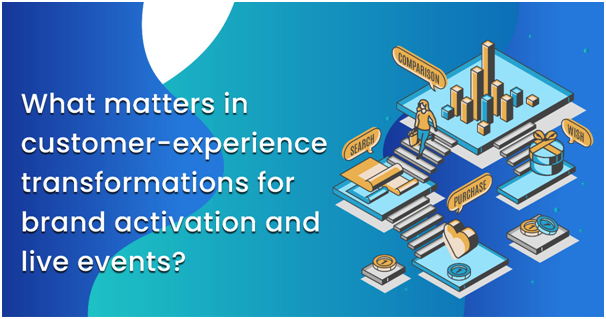What matters in customer-experience transformations for brand activation and live events?
Few will dispute the value of customer engagement, but businesses continue to struggle to reinvent their enterprises to reap the full benefits of outstanding customer service. Though, approaches differ depending on the maturity of the market and the prospects for customers. The most effective businesses focus is on three key elements: putting a clear objective, executing a disciplined transformation strategy, and powering the enablers to make it all work.
What is Customer experience transformation?
CX transformation is the process of changing an organization's principles, processes, procedures, technology, and culture to improve its customer experience capabilities by creating an ecosystem that can function with a customer-centric mindset and deliver high-quality CX at scale.
The structure identifies four main areas within the company where change is needed. These are the priority areas: vision, professionals, technology, and operations of the company.
Why is Customer Experience Transformation Important?
The issue is that today's users demand personalization and absolute synchronicity through all of their points of communication with a company, unlike traditional calling systems as they complete their customer journeys across multiple channels and touchpoints.
Businesses must build an organizational environment that allows for rapid response to consumer demands and thoughtfully planned and executed experiences, rather than a patchwork of fragmented brand interactions, for CX work to succeed at scale.
Decades of investment in organizational frameworks resulted in the creation of silos of responsibility within the company to manage different business units. These companies added separate digital-product categories to their operating infrastructure as they began providing services across digital platforms.
Brackets for Customer experience transformation
There are four key areas in the company where change is needed and four strategic building blocks that explain how change can occur.
Focus Areas: Where Change Should Take Place?
The focus areas reflect the areas of an enterprise that must shift to provide high-quality digital customer interactions at length.
Vision: Committed leadership that is dedicated towards a long-term, customer-focused approach.
Employees & Professionals: An organizational framework with a well-established network for cross-team, department, and silo collaboration.
Operations: New systems and procedures designed to encourage cross-functional cooperation and work towards a common goal.
Technology: A technical framework that facilitates cross-functional operations and customer experience management.
Building Blocks for Execution of Change: How Change Should Take Place
The efforts that organizations made within each target area include a mixture of strategies on four key dimensions.
Metrics & customer insights: Continuous collection and monitoring of actions, experience, and market metrics, and consumer sentiment, for continuously improved system performance.
Cultural control: The procedure of cultivating and maintaining a customer-centric and journey-focused working culture in an enterprise.
Experience-design performance: The concept and optimization of design standards for journey-level and relationship-level customer interactions.
Governance Structure: A structured framework for making decisions, adhering to regulations, and overseeing the organization's CX activities.
A multi-pronged approach to improving the customer experience
True customer-centric transformations often necessitate a rethinking of a company model itself, as this is the only way for the change to have maximum effect and be long-lasting. A radical shift in mindset centered on the consumer and improvements in the four above-mentioned key areas.
Vision: When a company decides to incorporate customer-experience strategies into everything it does, the first step is to create a mission statement that outlines the company's plans and expectations for how it will offer services to consumers in the future. This assertion will help the company concentrate, commit to leadership positions, and unite all workers around a common strategy. This will also help the workers in selecting customer-focused solutions in their daily jobs.
Employees & Professionals: The company must link workers and professionals across conventional organizational silos to deliver on the shared vision. A transformation-focused team should be developed following a given vision and strategy, leadership guidance to mentor and organize teams that have ownership over different phases of the customer journey to collaborate on the optimization of customer-journey experience.
Operations: The Customer experience program's leadership group should develop new working frameworks for facilitating effective working. These activities can result in a guide and toolkit for practical teams to use in their work to apply user-centric design and testing practices.
Technology: The technological infrastructure of a company may impose major limitations on the delivery of consistent customer experiences. Data fragmentation can result from the team and departmental silos, resulting in isolated data silos where information is fragmented and difficult to exchange across systems; this data fragmentation prevents companies from using data to enhance the consistency of their consumer interactions.
Conclusion: Each of the four building blocks refers to one of the four focus areas, offering a total of 4*4=16 items that the company can adhere to enhance customer experience. One of the reasons that CX change is challenging the sheer number of things to get right: many projects fail because crucial elements are overlooked, which is why using this method to identify your efforts is beneficial. All sixteen of these focus areas should be implemented through the enterprise to achieve maximum maturity. But when a company plans its transition, it should concentrate on foundational changes including governance, leadership, research operations, and technological infrastructures that support design operations and customer experience.
Source Links: https://www.nngroup.com/articles/framework-cx-transformation/
Contact Us
Sometimes magic is just someone spending more time on something than anyone else might reasonably expect.
Just a call away
Available: Mon-Sun 24 | 7
Atthah Info Media Pvt. Ltd.
Gurugram,
Haryana, India - 122001
+91 124 426 2229
+91 998 333 2229
For more details, just contact us at ask@atthah.com
Copyright © 2025. Atthah Info Media Pvt. Ltd. All Rights Reserved.

